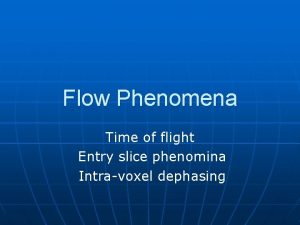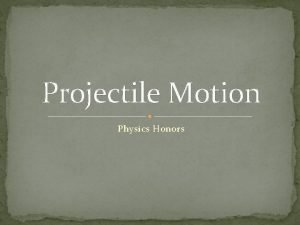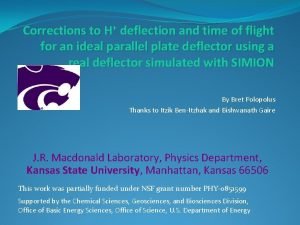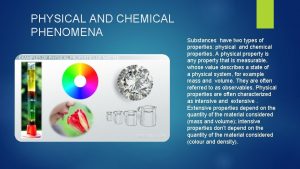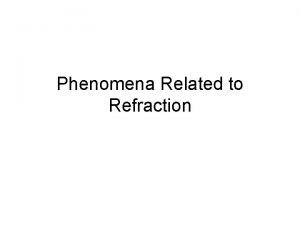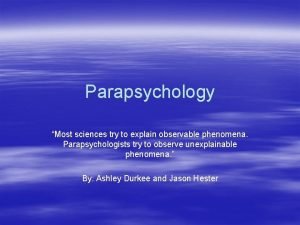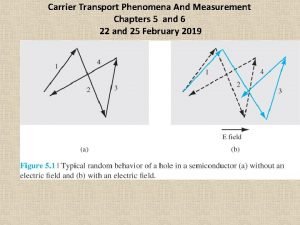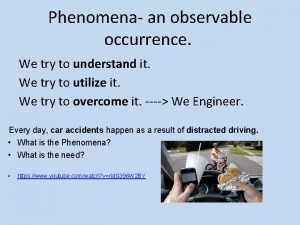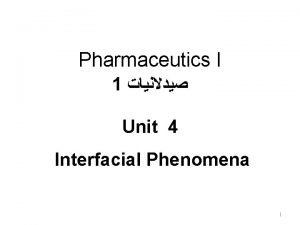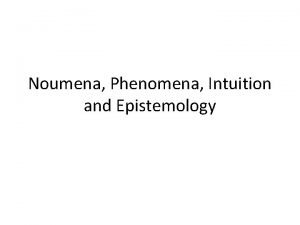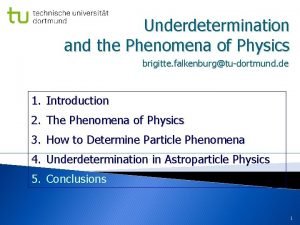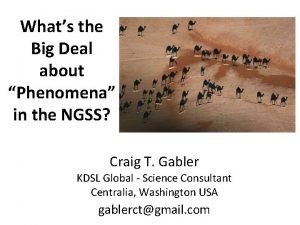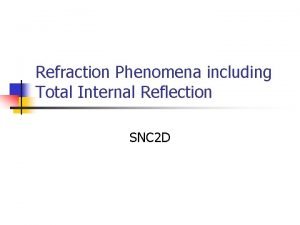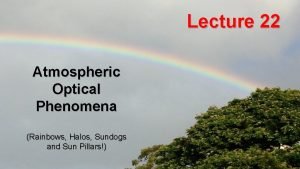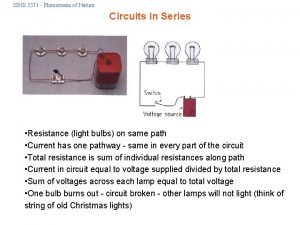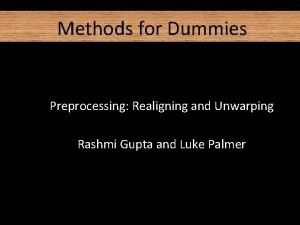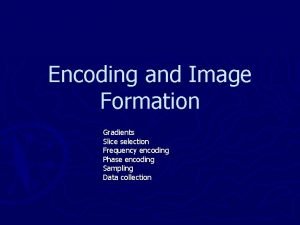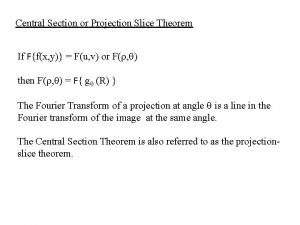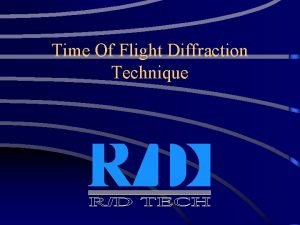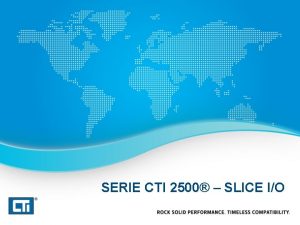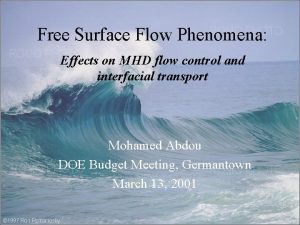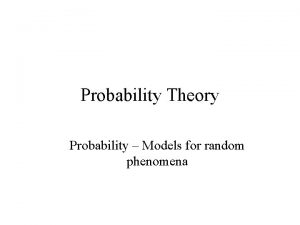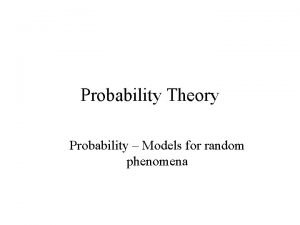Flow Phenomena Time of flight Entry slice phenomina












































- Slides: 44

Flow Phenomena Time of flight Entry slice phenomina Intra-voxel dephasing

Introduction n n Explores artefacts Produced from nuclei that move during the acquisition of data Flowing nuclei exhibit different contrast characteristics from their neighbouring stationary nuclei. Originate primarily from nuclei in blood and CSF The motion causes mismapping of signals and results in artefacts known as flow motion artefacts or phase ghosting. The cuases of flow artefact are known as flow phenomena

The principal phenomina n n n Time of flight Entry slice phenomina Intra-voxel dephasing

Mechanisms of flow n n Laminar flow – flow that is at different but consistent velocities. At the centre of the lumen of the vessel is faster than at the wall. The volocity difference across the vessel is constant. Turbulent flow – flow at different velocities that fluctuates randomly. Velocity difference across the vessel changes erratically. Vortex flow – flow that is initially laminar but then passes through a stricture or stenosis in the vessel. Flow at the centre of the lumen has a high velocity but near the walls, the flow spirals. Stagnant flow – the velocity of flow slows down to a point of stagnation. It behaves like stationary tissue.

Flow mechanisms Laminar flow vortex turbulance stricture Laminar flow (constant velocity)is termed first order motion

Time of flight phenomenon n n n To produce a signal, a nucleus must receive an excitation pulse and a rephasing pulse. If a nucleus receive only an excitation pulse but not rephased it does not produce a signal. If a nucleus is rephased but not received an excitation pulse it does not produce a signal Stationary nuclei always receive both excitation pulse and rephasing pulse and therefore produce a signal. Flowing nuclei present in the slice for excitation may exit the slice before rephasing and therefore not produce signal. This is called the time of flight phenomenon The effect of the phenomenon depends on the types of pulse sequence used.

Time of flight in spin echo pulse sequences n n n n In spin echo a slice is selected and a 900 excitation pulse and a 1800 rephasing pulse are applied. Every slice is selectively excited and rephased. Stationary nuclei wihin the slice receive both pulses and produce a signal Nuclei flowing perpendicular to the slice may be present for the excitation pulse, but may not for the rephasing pulse. They may not produce a signal Similarly new nuclei which have not received excitation pulse may be precsent for the rephasing pulse They also not produce a signal This will result in a signal void from the nuclei, so the vessel appear dark

Time of flight phenomenon in spin echo 1800 900 Flowing nuclei excited rephased No signal excited Not rephased slice No signal

Factors affecting the time of flight effect n n n Velocity of flow TE Slice thickness

Velocity of flow n n n At high velocity only a smaller proportion of nuclei are present for both excitation and rephasing pulses. As the velocity increases the time of flight effect is increased. At slow velocity more nuclei will be present for both excitation and rephasing pulses. Therefore, as the velocity decreases the effect of time of flight effect decreases. This is called flow related enhancement

Effect of TE on TOF n As the TE increases, a higher proportion of flowing nuclei have exited the slice between the excitation pulse and the rephasing pulse. Therefore with increasing TE the signal void increases.

Slice thickness & TOF n n n For a given constant velocity a nucleus take longer time to travel through a thicker slice. Therefore the nuclei are more likely to receive both excitation and the rephasing pulse. So the TOF effect is less on thick slices than on thin slices. Thick slice signal Thin slice Signal void

Time of flight in gradient echo pulse sequences n n n In gradient echo a variable RF excitation pulse is followed by a gradient rephasing. Each slice is selectively excited by the RF pulse, but the rephasing gradient is applied to the whole body So the flowing nucleus which was excited by the RF pulse is rephased by the gradient even if it has exited the slice, and produces a signal. In addition the short TR tend to saturate the stationary nuclei and the flowing nuclei appear to have a higher signal. Therefore in GE pulse sequences the flow signal enhancement is increased. So the GE sequences are said to be flow sensitive

Summary n Time of flight phenomina produce • flow related enhancement • high velocity signal loss n n or Flow related enhancement increases as the: • • • Velocity of flow decreases TE decreases Slice thichness increases • • • Velocity of flow increases TE increases Slice thickness decreases High velocity signal void increases as the:

Entry slice phenomenon (in-flow effect) n n n Entry slice phenomenon is related to the excitation history of the nuclei. Nuclei that receive repeated RF pulses during the acquisition are said to be saturated or ‘beaten down’. The NMV of these nuclei eventually reach an equilibrium position, and produce a signal according to the TE, TR, flip angle and contrast characteristics of the tissue. Nuclei that have not received repeated RF pulses are said to be ‘Fresh’ as their NMV has not been beaten down. The signal produced by the ‘fresh’ nuclei and the ‘beaten down’ nuclei are different.

Saturated and fresh spins Magnetic moments beaten down by repeated RF puses Satuurated spins Fresh spins

n n n Stationary nuclei within a slice become saturated after repeated RF pulses. Nuclei flowing perpendicular to the slice enter the slice fresh. They therefore produce a different signal from the stationary signal. This is called entry slice phenomenon or in -flow effect (as it is more prominent in the first slice of a ‘stack’ of slices. The slices in the middle of the stack exhibit less entry slice phenomenon ( as flowing nuclei have received more excitation pulses by the time they reach these slices)

Factors affecting the magnitude of entry slice phenomenon (ESP) n n TR - short TR reduces the magnitude of ESP Slice thickness – ESP increase with the slice thickness Velocity of flow – ESP increases as the velocity of flow increases Direction of flow – ( is the most important in determining the magnetude of ESP ) – next slide

Direction of flow n n n The direction may be co-current (same direction as the slice selection) or counter -current (opposite direction to the slice selection) Co-current flow – ESP decreases rapidly in the direction of slice selection Counter-current flow – ESP is more prominent and may still be present deep within the slice stack

Co-current & counter current flow vessel Cocurrent Counter -current Slices 1 2 3 4

Summary n ESP increases: • At the first slice in the stack • When using a long TR • In thin slices • With fast flow • In counter-current flow

Intra-Voxel dephasing n n n n Gradients alter the magnetic field strength, precessional frequency and phase of nuclei. Nuclei flowing along a gradient rapidly accelerate or decelerate depending on the direction of flow and gradient application. Flowing nuclei therefore either gain phase or loose phase If a flowing nucleus is adjacent to a stationary nucleus in a voxel, there is a phase difference between the two nuclei. Therefore nuclei wihin the same voxel are out of phase with each other This will result in a reduction of total signal amplitude from the voxal. This is called intra-voxel dephasing.

Type of flow and IVD n n n The magnitude of intra-voxel dephasing depends on the degree of turbulence. In turbulent flow, IVD effects are irreversible. In laminar flow, the IVD can be compensated for as long the velocity is constant.

Summary n n Flow affects image quality Time of flight effects give signal void or enhancement Entry slice phenomenon effects give a different signal intensity to flowing nuclei The signal intensity of the lumen is also affected by the mechanism of flow

Flow phenomena compensation n Flowing nuclei produce a very confusing range of signal intensities. Ideally, these should be compensated for, inorder to minimise their adverse effects on image quality and interpretation. There are several methods to help minimise flow artefacts.

1. Gradient moment rephasing(nulling) n n n n Gradient moment rephasing compensates for the altered phase values of nuclei flowing along a gradient. It uses additional gradients to correct the altered phases back to their original values. In this way, flowing nuclei do not gain or loose phase due to the presence of the main gradient. This is performed by using slice select gradient and/or readout gradient. The gradient alters its polarity from positive to double negative and then back to positive again. A flowing nucleus traveling along these gradients, experiences different magnetic field strengths. In order to compensate altered phase values, the precessional frequency at the beginning of gradient moment rephasing must be the same as it is at the end. The net precessional frequency and phase change must therefore be zero.

Gradient moment rephasing Frequency of a stationary nucleus along a normal gradient 0 +4000 Hz +8000 Hz +4000 Hz -16000 Hz +12000 Hz 0 Frequency of a stationary nucleus along the compensatory gradient Phase of a flowing nucleus Frequency of a flowing nucleus 0 +4000 Hz -12000 Hz 0 0

Result of gradient movement rehasing n n n Gradient moment rephasing reduces intravoxel dephasing. As flowing nuclei have the same phase as stationary nuclei in the same voxel, their signals add constructively and therefore a brighter signal results. Gradient momemt rephasing gives flowing nuclei a bright signal as spins are in phase.

Note n n n Gradient moment rephasing assumes a constant velocity across the gradients. Most effective in slow laminar flow (1 st order motion) More effective in venous rather than arterial flow. As it uses extra grdients minimum TE is increased Fewer slices may be obtained for a given TR As flowing nuclei are bright usually used for T 2* weighted images where fluid (blood & CSF) is bright anyway.

Example Without GMR – shows mismapping of the flowing nuclei within the aorta (arrow) With GMR

Pre-saturation n n Pre-satuation pulses are used to nullify the signal from flowing nuclei so that the effects of entry slice and TOF phenomena are minimised. It delivers a 900 RF pulse to a volume of tissue outside the FOV. The flowing nuclei within the volume receives this pulse. When they enter the slice stack, they receive the excitation pulse and become saturated. If it is fully saturated to 1800, it has no transverse component of magnetization and produce a signal void.

Flowing nuclei Saturation volume vessel Pre-saturation RF pulse Stationay nuclei Excitation pulse FOV

Caution! n n n To be effective, pre-saturation pulses should be placed between the flow and the imaging stack. In sagital and axial imaging it is usually placed above and below the FOV. Right and left sturation pulses are some times used in coronal imaging of chest to saturate flow from subclavion vessels. Pre-saturation pulses are only useful if they are applied to tissue. If they are applied to air they are not effective. They increase the amount of RF that is delivered to the patient, and increase heating effect.

Caution! n n Pre-saturation pulses are applied around each slice just before the excitation pulse. The TR, and the number of slices govern the interval between the delivery of each pr-saturation pulse. To optimise pre-saturation, use all the slices permitted for a given TR. As pre- saturation produces a signal void, it is usually used in T 1 and proton density weighted images where fluid (blood & CSF), is dark anyway.

Example -pre-saturated images Artefact from flowing nuclei within aorta (without saturation) T 1 weighted imaes With pre-saturation

Other uses of pre-saturation n n Pre-saturation nullifies signal and can therefore be used to specifically eliminate certain signals. The main uses of this are: • fat and water saturation • to reduce aliasing

1. Fat & water saturation n n In fat hydrogen is linked to carbon and in water it is linked to oxygen. Therfore the precessional frequency of hydrogen in water and fat are different. AT 1. 5 T field strength this difference is 220 Hz ( less in fat). To saturate fat signal, a 900 pre-saturation pulse must be applied at the precessional frequency of fatt to the whole FOV. To saturate water signal, the pre-saturation pulse at the precessional frequency of water is applied to the whole FOV

Fat & water saturation pulses Water saturation Fat saturation Water peak Saturation pulse Fat peak 220 Hz Saturation pulse 220 Hz

Examples Sagital T 1 weighted images Without fat saturation With fat saturation

n T 1 weighted image without water saturation n T 1 weighted image with water saturation

2. pre-saturation to prevent aliasing n Aliasing is produced when anatomy exists outside the FOV. It can be reduced by pre-saturation to prevent signals from tissue outside the FOV. However there anti-aliasing methods to prevent aliasing (discused later).

Summary 1. Gradient Moment Rephasing: • Uses additional gradients to correct altered phase values • Reduces artefact from intra-voxel dephasing • Gives flowing nuclei a bright signal • Is mainly used in T 2 or T 2* weighted images • Is most effective on slow, laminar flow within the slice

Summary 2. Pre-saturation: • Uses additional RF pulses to nullify signal from flowing nuclei • Reduces artefacts due to time of flight and entry slice phnomenon • Gives flowing nuclei a signal void • Is mainly used in T 1 weighted images • Is effective on fast and slow flow • Increases the RF deposition to the patient • Can be used to nullify signal from fat or water and to reduce aliasing.

END
 Entry slice phenomenon
Entry slice phenomenon Fight flight freeze fawn quiz
Fight flight freeze fawn quiz Time slice windows analysis
Time slice windows analysis Single entry system introduction
Single entry system introduction New entry entrepreneurship
New entry entrepreneurship Farm records and accounts
Farm records and accounts Range in physics formula
Range in physics formula Projectile motion equations
Projectile motion equations Far 117 duty limits
Far 117 duty limits Ideal projectile motion equation
Ideal projectile motion equation Simion 0408
Simion 0408 Logging flight time
Logging flight time An aircraft monikko
An aircraft monikko Some natural phenomena class 8 ppt
Some natural phenomena class 8 ppt Physical and chemical phenomena
Physical and chemical phenomena Phenomena related to refraction of light
Phenomena related to refraction of light Observable phenomena psychology
Observable phenomena psychology Objective consideration of contemporary phenomena
Objective consideration of contemporary phenomena Natural language processing
Natural language processing Reference phenomena in nlp
Reference phenomena in nlp Which are not purely surface phenomena
Which are not purely surface phenomena Gravitation is a natural phenomenon where:
Gravitation is a natural phenomenon where: Carrier transport phenomena
Carrier transport phenomena Anchor phenomena
Anchor phenomena Observable phenomena meaning
Observable phenomena meaning Surface and interfacial phenomena
Surface and interfacial phenomena Reoulox phenomena
Reoulox phenomena Global climate phenomena
Global climate phenomena Random phenomena
Random phenomena Phenomena vs noumena
Phenomena vs noumena Sinusoidal real life examples
Sinusoidal real life examples What is the meaning of phenomena
What is the meaning of phenomena Https://slidetodoc.com
Https://slidetodoc.com Noumena vs phenomena
Noumena vs phenomena Noumena vs phenomena
Noumena vs phenomena Critical angle and total internal reflection
Critical angle and total internal reflection Optical phenomena rainbow
Optical phenomena rainbow Noumena vs phenomena
Noumena vs phenomena Every pale tomato slice
Every pale tomato slice Slice selection
Slice selection Sarah bohndiek
Sarah bohndiek Slice selection gradient
Slice selection gradient Central slice theorem
Central slice theorem Forehand slice
Forehand slice Cross slice
Cross slice
